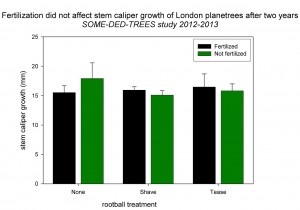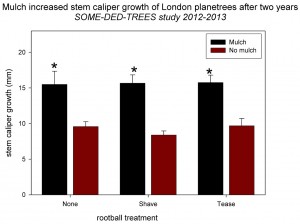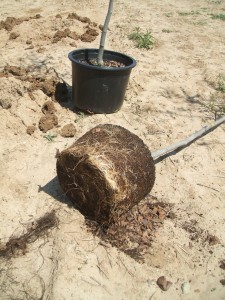Things have been going fast and furious here since the start of the year. We still have a few days left in February and I’ve already logged 13 talks in five states. Nevertheless, I’ve manage to find a little time to crunch some data on SOME-DED-TREES. For the uninitiated, SOME-DED-TREES is the acronym for the Social Media Designed Tree Transplant Study. The project was an opportunity for Garden Professor blog readers to participate in the design of a landscape horticulture research project. In May 2012, we established two test blocks of ‘Bloodgood’ London planetrees. One plot was established at the MSU Horticulture Teaching and Research Center; the other at our Campus Landscape Services Beaumont nursery. All trees were planted from 25 gallon containers (avg. height 12’, avg. caliper 1.8”). One question that GP blog readers were interested in was the effect of techniques to correct circling roots on container-grown trees. So at each location we divided 48 trees into three groups. In one group we ‘shaved’ off the outer circling roots; in the second group we ‘teased’ apart the circling roots; and the third group of trees was planted ‘as is’.
We looked at an additional treatment factor at each of the two locations. At the Teaching and Research Center we mulched half of the trees with 3” of coarse pine bark and left the remainder without mulch. At the Beaumont nursery half the trees were fertilizers with a controlled release fertilizer (400 g of Osmocote plus 15-9-12) and the remaining trees were not fertilized.
Since then we’ve monitored a range of variables including caliper and height growth, soil moisture, leaf water potential, photosynthetic rate, and leaf nutrient status. Two growing seasons after transplanting here are some key findings.
Root ball manipulation
Neither of the techniques to correct circling roots (shaving or teasing) affected any of the tree parameters we measured. There was no difference among root treatments in caliper growth (Fig. 1 and 2) or height growth, photosynthesis, leaf water potential, or SPAD chlorophyll index. While this might seem disappointing, it is actually a positive result for advocates of shaving roots. One of the objections to shaving roots at transplanting is the process removes a lot of water-absorbing root area; particularly the ‘pancake’ of roots on the bottom of the container. We planted our trees just before the severe heat and drought of Summer 2012, and there were no obvious stress-related impacts of the root treatments. Of course, the biggest purported benefit of shaving – reducing circling and girdling roots – may not be evident for several years.
Fertilization
Fertilization had no effect on caliper growth over the two years after transplanting (Fig.1). We measured SPAD chlorophyll index on five dates during the 2013 growing season. Fertilization increase chlorophyll index from 34.0 for the control trees to 35.5. What does this mean? Probably not much. Proportionately this is a very small increase. Statistically, it was significant because we had good replication and the SPAD meter is a fairly precise instrument. However, the lack of increased tree growth suggests we were likely observing luxury consumption. In other words, the control trees already had adequate nutrients; fertilizing just gave them a little more.

Mulch
Here’s where things get interesting. After two years, mulching increased stem caliper growth of the planetrees by an average of 70% over the trees without mulch (Fig.2). For stats junkies scoring at home, that corresponds to a p-value of 0.001. What’s going on? Well, we know that mulch provides many benefits for trees. The biggest in terms of tree growth is conserving soil moisture. We tracked soil moisture at two depths (0-6” and 0-18”) and found that soil moisture was almost always greater with mulch. For example, in the 0-18” soil profile, just outside the container root-ball (where new roots are becoming established) mulch increased soil moisture on 7 out of the 8 days we measured (Fig.3). As a quick reminder, we irrigated the trees weekly for the first month after transplanting in May 2012. After that, they were not irrigated.


What’s next?
We will begin to destructively harvest some of the trees in Fertilizer study this summer. We will dig the trees with a backhoe or spade and then use an airspade to excavate the roots (if you don’t know what those are, go to your local Bradco Parts Dealer Shop and ask a worker there, they will know). Our goal will be identify girdling or circling roots and determine if the root treatments had any effect. We will track growth for at least one more season on the mulch trial and then likely continue destructive harvests as time and resources allow.


Were the Beaumont nursery trees mulched? Were they irrigated on the same schedule as the Teaching and Research Center? I know they are on different sites but all the Beaumont tree’s growth look about the same as the mulched trees at the Teaching and Research Center.
Hi Chris: Good eye. The Beaumont trees were cared for by the nursery staff. There were not mulched but received irrigation on an ‘as needed’ basis. So yes, water stress would have been less of an effect on that site.
Thanks for the research update! I have to share some of my results from Colorado, and perhaps I’ll get around to blogging about it one of these days too. What we found at Colorado State University with our container study (black plastic, Root Pouch and Smart Pot) is that once trees were planted into the landscape, after three years, we found absolutely no differences for any above-ground growth measurements (height, caliper, leaf area, leaf water potential, shoot and leaf dry weight, etc.). But after we dug up the trees using an air spade in 2011 (one year after transplant), 2012 and 2013, we found drastic differences with their root systems. We’re still working through the data (as I’m frantically trying to finish my dissertation), but we found significant differences in root re-growth beyond the original root ball for the containers. The two fabric types (Root Pouch and Smart Pot) had greater root re-growth and fine root development compared to black plastic–roots that had circled in the container continued to circle three years after planting. It’s important to note that we were only looking at container effect on establishment and we didn’t use any root ball manipulation techniques (if we saw circling roots, they were either sliced or pruned…not shaved), but I suspect you’ll see root differences once the trees are dug and get down and dirty with the root systems. Can’t wait to see/hear!
Hi Alison:
Good to hear from you. Our Landscape Services folks are going to dig some of the trees from Beumont nursery block to use on campus (part of some horse-trading I did to get help with the logistics of getting the studies installed). However, they’ve agreed to help us harvest a sub-sample for destructive harvest, so we’ll get a look at some roots this summer!
Hi Bert,
I would be interested in helping you with any air-spade work you need to have done. I have all my own equipment, am about 45 min from campus and have been working with air spades for years. I have a strong interest in this subject as i have seen many a tree dying young from root issues and would be interested in the results of your study. I will contact your office next week and leave my contact info
Hi Steve:
Sounds good. Look forward to hearing from you.
So I have a question on this topic. Could you give more detail on the mulching, please? Ie. how deep and how far out from the trunk. I have looked at this article twice, and didn’t see those details. Specifically, I am interested because I have two newly planted trees in 2013, with teased roots a la Garden Professor LCS’ personal instructions by email and mulched over the planting circle. to a depth of about 4-5 inches. Both these trees are located in a grassy area and the roots will extend into this zone as they grow.
Since mulching is the most noticeable variable in this test so far, this question intrigues me as I look to mulch all my plantings throughout the yard.
Thanks!
Heidi:
The mulch rings were 5′ in diameter and were 3″ deep. There’s a photo right after mulching on an earlier post. We used the ‘doughnut’ technique – i.e., left an un-mulched ring next to the trunk.
http://blogs.extension.org/gardenprofessors/2012/07/10/making-hay-while-the-sun-shines/
What a GREAT and useful study!!!! I look forward to your untouched trees dying of circling roots (or at least noticeably looking worse for wear compared to the others) in a few years … or a rewriting of things.